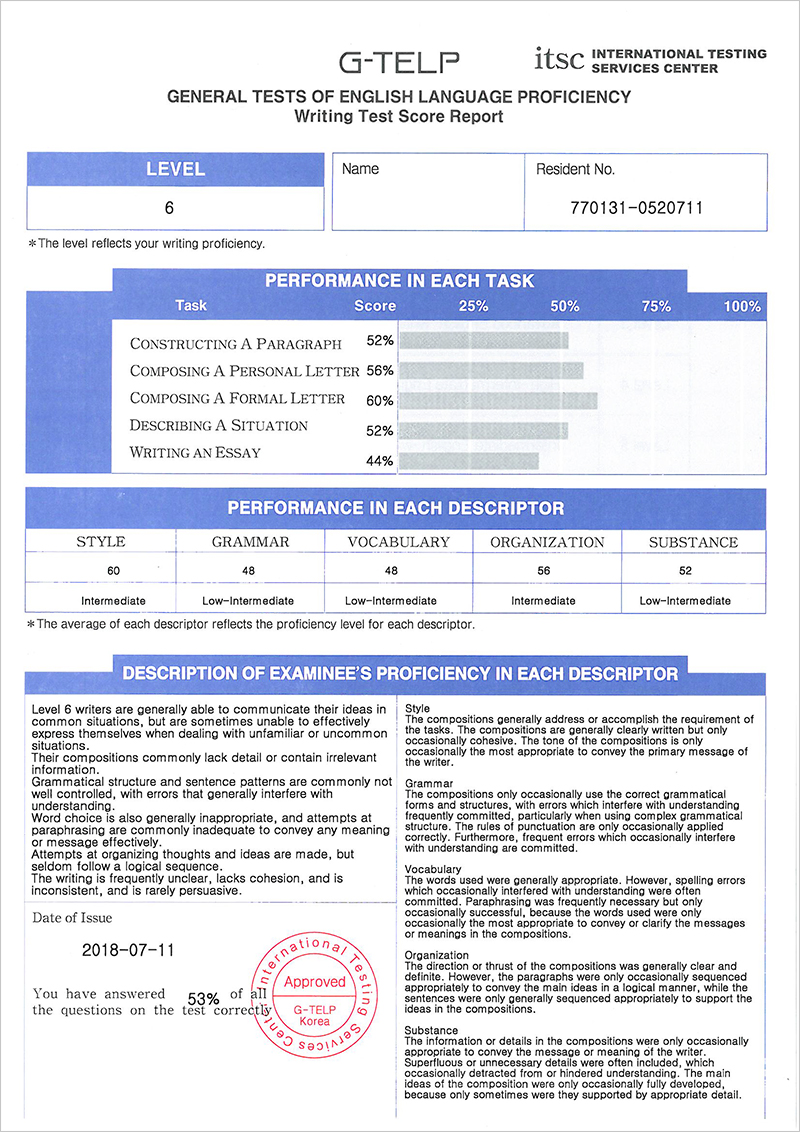





The G-TELP Writing Test evaluates English writing proficiency.
The G-TELP Writing Test is designed to assess the general English writing proficiency of non-native English speakers.
| Test Type |
Part 1. Constructing a Paragraph Part 2. Composing a Personal Letter Part 3. Composing a Formal Letter Part 4. Describing a Situation Part 5. Writing an Essay |
|---|---|
| Duration | 60 minutes |
| Availability of Score Report | 7 working days |
| Level | Levels 1 to 11 |
| Descriptor | Grammar, Vocabulary, Organization, Style, Substance |
| Duration of Score Validity | Two (2) years |
These tasks simulate real-life activities, such as school assignments, work reports, cultural articles, scientific journals, media ads, and personal letters. Each writing task gives examinees the opportunity to develop and organize ideas in response to a set of requirements, and to express those ideas in English.
The G-TELP Writing Test is composed of five (5) parts. Each part requires examinees to write compositions in response to specific situations and questions.
| Part 1 | Constructing a paragraph | compose a paragraph based on the title provided |
|---|---|---|
| Part 2 | Composing a personal letter | compose a personal letter in response to the situation depicted |
| Part 3 | Composing a formal letter | compose a formal letter in response to the situation depicted |
| Part 4 | Describing a situation | write a detailed article about the information presented in a graph, chart, or table |
| Part 5 | Writing an essay | compose an essay on the topic |
| Level 1 | Authentic | Authentic |
|---|---|---|
| Level 2 | Highly Advanced | Advanced |
| Level 3 | Advanced | |
| Level 4 | High-Intermediate | Intermediate |
| Level 5 | Intermediate | |
| Level 6 | Low-Intermediate | |
| Level 7 | High-Basic | Basic |
| Level 8 | Basic | |
| Level 9 | Low-Basic | |
| Level 10 | Beginner-Basic | |
| Level 11 | No-Mastery | No Mastery |
The G-TELP Writing Test assesses the English writing proficiency of non-native English speakers and forms a powerful battery of measuring tools that can help people achieve higher levels of proficiency in the English language.
Level 1 writers are able to express themselves with ease in all situations, whether familiar or unfamiliar.
Level 2 writers are able to communicate their ideas effectively in nearly all situations.
Level 3 writers are usually able to communicate their ideas effectively in nearly all situations.
Level 4 writers are generally able to communicate their ideas in most situations.
Level 5 writers are generally able to communicate their ideas in common situations, but may occasionally have trouble when dealing with unfamiliar or uncommon events.
Level 6 writers are generally able to communicate their ideas in common situations, but are sometimes unable to effectively express themselves when dealing with unfamiliar or uncommon situations.
Level 7 writers generally have a difficult time communicating their ideas in common situations, and are often unable to effectively express themselves when dealing with unfamiliar or uncommon situations.
Level 8 writers usually have a difficult time expressing their ideas in common situations, and are frequently unable to effectively respond when dealing with unfamiliar or uncommon situations.
Level 9 writers frequently have a difficult time communicating their ideas in common situations, and are almost always unable to effectively respond when dealing with unfamiliar or uncommon situations.
Level 10 writers almost always have a difficult time expressing their ideas, even in common or familiar situations.
Level 11 writers may exhibit a vocabulary of a handful of memorized words and isolated phrases only. They are unable to express themselves in a meaningful way.
The G-TELP Writing Test provides examinees with information about their specific strengths and weaknesses in order to improve their writing proficiency in the English language.

The Mastery Score indicates proficiency in the English language. Mastery is demonstrated when an examinee scores 75% in all skill areas. Near Mastery is demonstrated when an examinee scores 75% in two of the skill areas. No Mastery is demonstrated when an examinee answers less than 75% on more than three skill areas.
A Skill Area Score of 75% or more indicates mastery of the particular skill area. Total scores for each separate section of the test are reported. Scores can range from 0-100%.
The raters evaluate cohesiveness and clarity of the writing, along with how persuasive the composition was.
The raters evaluate the degree to which the examinee applies the correct grammatical structures, sentence patterns, and rules of punctuation.
The raters evaluate the degree to which the examinee uses the appropriate English words or terms, and the extent and precision of the terminology used.
The raters evaluate the degree to which sentences and paragraphs maintain a logical progression of ideas from the initial presentation to the conclusion.
The raters evaluate the degree to which topics are established and ideas and messages are developed.